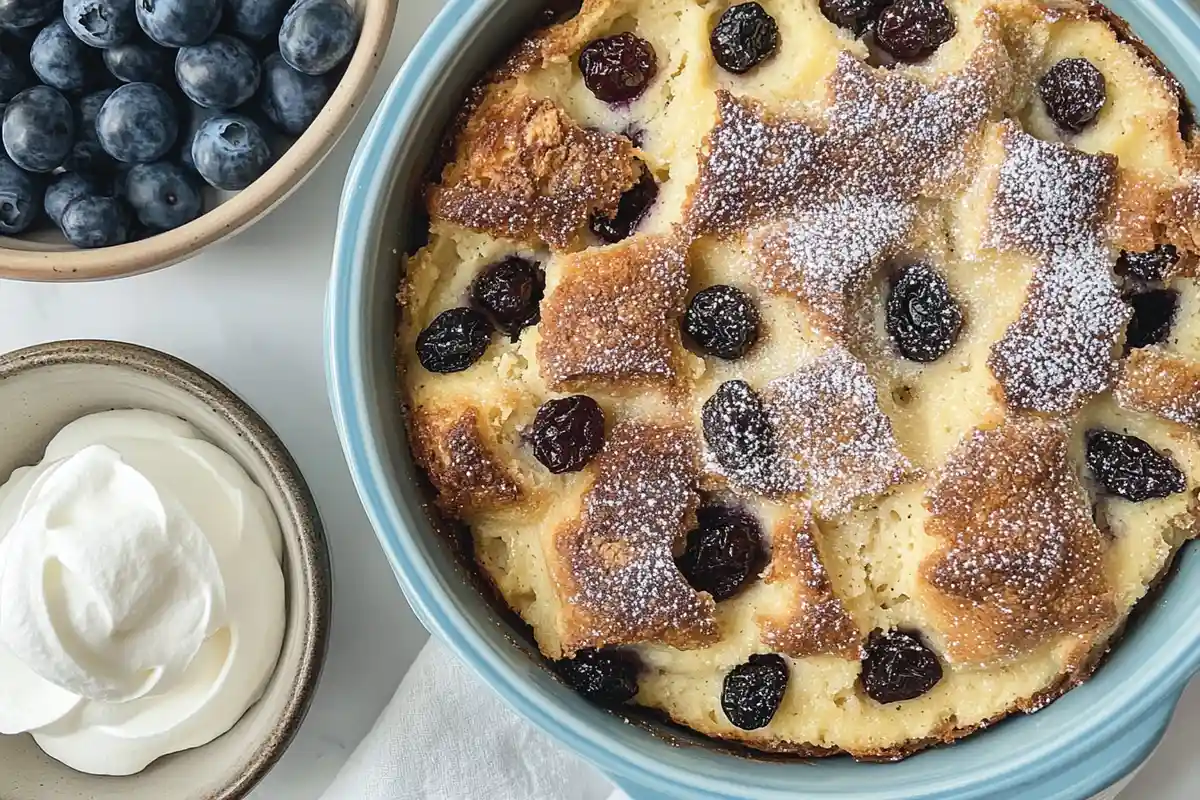Bread pudding is a time-honored dessert loved for its comforting richness and ability to transform simple ingredients into something extraordinary. Its versatility makes it a staple in dessert menus across cultures, but have you ever considered taking this classic dish to the next level? Enter the sourdough bread pudding recipe—a unique and flavorful twist that will excite your taste buds and warm your soul.
This article dives deep into the world of sourdough bread pudding recipe. We’ll explore what makes this dessert unique, why sourdough bread is an exceptional choice for this dish, and how to prepare it step-by-step for the perfect result. Whether you’re a dessert enthusiast, a health-conscious foodie, or seeking a new culinary adventure, this guide will arm you with everything you need to create a showstopping dessert.
If you’re passionate about exploring new ways to use sourdough, there’s so much more waiting for you! Check out some of my other delicious recipes, like Asiago Sourdough Bagels for a flavorful breakfast, or The Best Sourdough Stuffing for your next holiday meal. For savory cravings, don’t miss the Sourdough Garlic Bread, and if you’re ready to experiment, try the wholesome Buckwheat Sourdough Bread. Let’s dive in and make your kitchen the heart of delicious creations!
Table of Contents
Why Use Sourdough Bread for Bread Pudding?
Unique Flavor Profile of Sourdough
Sourdough bread stands out because of its naturally tangy and complex flavor, achieved through fermentation. When baked into bread pudding, this tanginess complements the sweet custard base, creating a flavor balance that’s both sophisticated and comforting. Unlike standard white bread, which can feel one-dimensional, sourdough adds a layer of depth that elevates the entire dish.
Moreover, sourdough’s slightly chewy texture holds up beautifully when soaked in the custard mixture. Instead of becoming overly mushy, it maintains a delightful balance of softness and structure, essential for achieving the perfect bread pudding consistency.
Benefits of Sourdough in Desserts
Sourdough bread isn’t just a tasty choice—it also comes with nutritional perks. Thanks to its fermentation process, sourdough is easier to digest and has a lower glycemic index than many other types of bread. For dessert lovers mindful of sugar intake or prefer a lighter indulgence, sourdough bread pudding strikes a happy medium.
Moreover, sourdough bread’s naturally tangy flavor reduces the need for excessive sugar in the recipe, making it a better option for those seeking a dessert that satisfies without overwhelming sweetness. Pair that with the texture it brings to the table, and you’ll see why this ingredient is the show’s star.
Essential Ingredients for Sourdough Bread Pudding
Crafting the perfect sourdough bread pudding recipe begins with assembling the right ingredients. The beauty of this dessert lies in its simplicity, as it uses common pantry staples to create something truly indulgent. However, sourdough bread adds an unexpected twist, taking the recipe from ordinary to extraordinary.
Below, you’ll find a breakdown of the key ingredients, suggestions for substitutions, and ideas for customization that will let you make this dish uniquely your own.
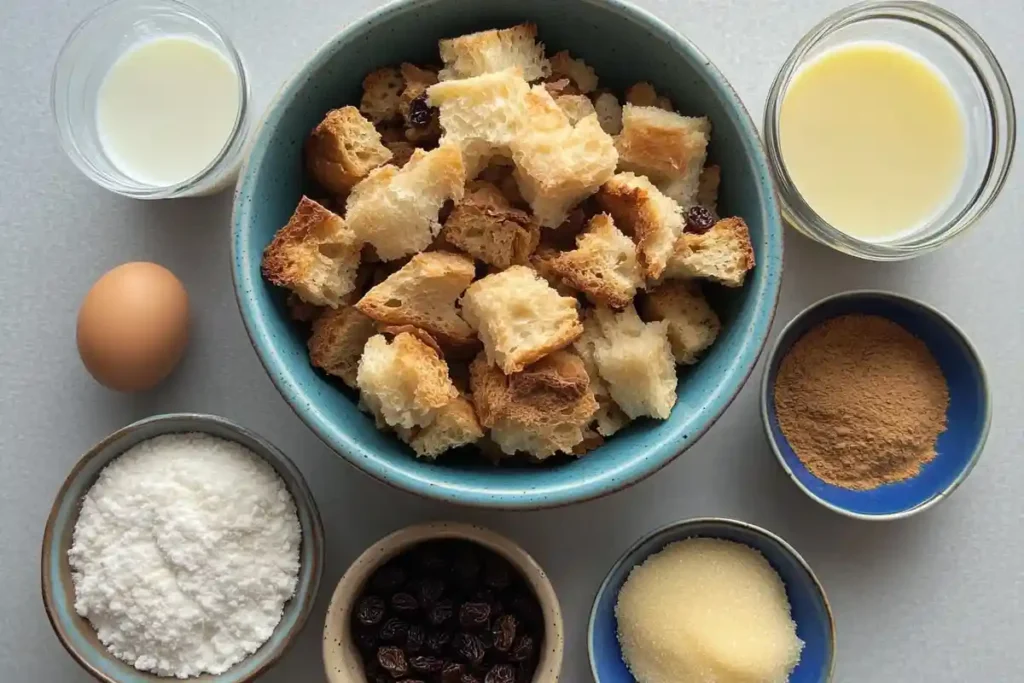
List of Key Ingredients
To make a classic sourdough bread pudding, you’ll need the following:
- Sourdough Bread: The star ingredient, sourdough bread provides the tangy, complex flavor and sturdy texture that set this pudding apart.
- Milk and Cream: These create a rich custard base. Combining whole milk and heavy cream is traditional, but you can tweak this to suit your dietary needs.
- Eggs: Essential for binding the pudding and giving it that luscious, creamy texture.
- Sugar: Granulated sugar is typically used to sweeten the dish, but you can also experiment with alternatives like brown sugar or coconut sugar for a deeper flavor.
- Vanilla Extract: Adds warmth and enhances the dessert’s flavor profile.
- Spices: Cinnamon and nutmeg are the go-to spices for bread pudding, lending a cozy, aromatic touch.
These core ingredients create the foundation of the dish. However, the beauty of sourdough bread pudding lies in its adaptability, so let’s explore some substitutions and add-ins to make it your own.
Explanation of Ingredient Substitutions
Whether catering to dietary restrictions or experimenting with new flavors, ingredient substitutions can help make this dessert more inclusive or innovative. Here are some tips:
- Dairy-Free Options: Substitute the milk and cream with almond, coconut, or oat milk for a lactose-free version. Just ensure that the liquid is thick enough to create a creamy custard.
- Alternative Sweeteners: Swap white sugar for honey, maple syrup, or stevia to reduce refined sugar content. Brown sugar can also be used for a deeper, molasses-like sweetness.
- Egg-Free Version: For a vegan option, you can replace eggs with a flaxseed meal or a commercial egg replacer. However, note that the texture may vary slightly.
- Gluten-Free Version: To accommodate gluten sensitivities, use gluten-free sourdough bread (readily available at specialty bakeries or health food stores).
Choosing the Best Sourdough Bread
The type of sourdough bread you choose can significantly impact the final dish. Here’s what to consider:
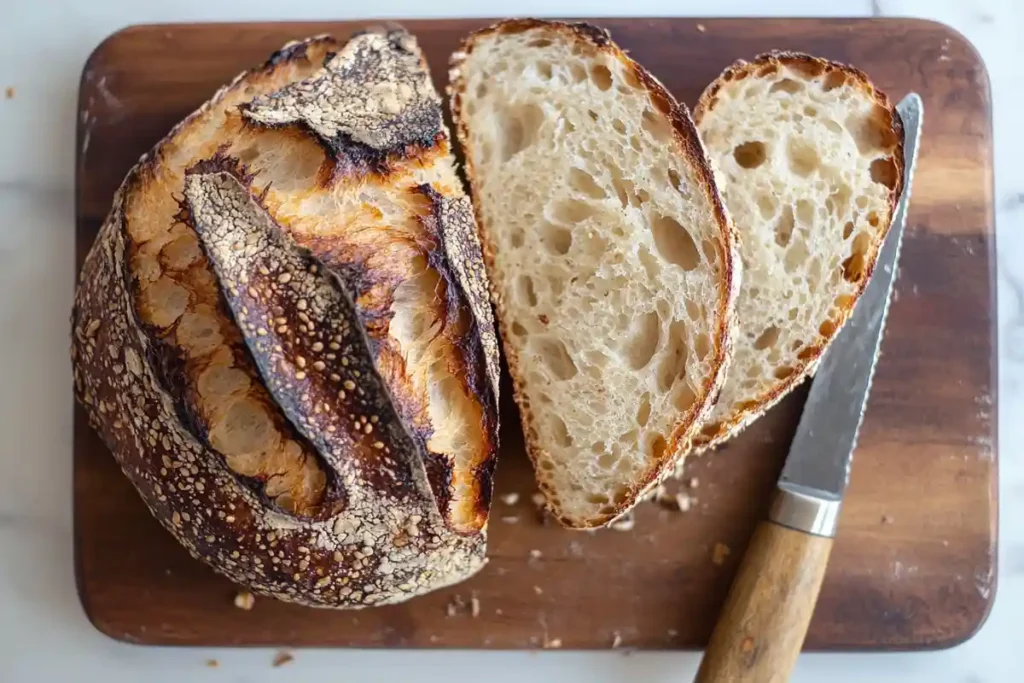
Fresh vs. Day-Old Bread: Which Works Best?
Day-old bread is preferred for bread pudding because it’s drier and absorbs the custard more effectively without turning mushy. If your bread is fresh, you can replicate this effect by lightly toasting it or leaving it to dry for a few hours.
How the Tangy Flavor Enhances the Dessert
Sourdough’s natural tanginess creates a beautiful contrast with the sweet custard. It also enhances the overall complexity of the dish, making it more memorable than traditional versions.
Best Types of Sourdough Bread
Opt for artisan sourdough loaves or whole wheat sourdough for a nuttier flavor. Avoid sourdough varieties with added garlic or herbs, as these can clash with the dessert’s sweetness.
Additional Ingredients for Variations
Want to take your sourdough bread pudding recipe to the next level? Here are some popular add-ins and toppings to consider:
Popular Add-Ins
- Raisins or Dried Fruit: A traditional addition that adds bursts of sweetness.
- Nuts: Chopped pecans, walnuts, or almonds provide crunch and contrast to the soft pudding.
- Chocolate Chips: For a more decadent twist, sprinkle chocolate chips.
Seasonal Options
- Pumpkin Puree: Perfect for fall, adding a cozy, spiced flavor.
- Berries: Fresh or frozen berries (like blueberries or raspberries) can add a tart, fruity note.
- Citrus Zest: Orange or lemon zest brightens the dish and complements the tangy sourdough.
Optional Toppings
- Caramel Sauce: Drizzle over the top for an extra layer of indulgence.
- Whipped Cream: Adds a light and airy element to balance the richness.
- Powdered Sugar: A simple but elegant finishing touch.
By choosing the right sourdough bread, experimenting with add-ins, or adjusting ingredients to meet your dietary needs, you can tailor this dish to your preferences.
Preparing Your Sourdough Bread Pudding
Now that you’ve gathered your ingredients and selected the perfect sourdough bread, it’s time to bring everything together. The preparation process is simple yet crucial to achieving the ideal texture and flavor in your sourdough bread pudding recipe. Each step plays a key role in the final result, from prepping the bread to making the custard and combining it all. So, let’s dive into the details and ensure your bread pudding turns out flawless.
Prepping the Sourdough Bread
Before assembling the dish, preparing your sourdough bread properly is important. Here’s how to do it:
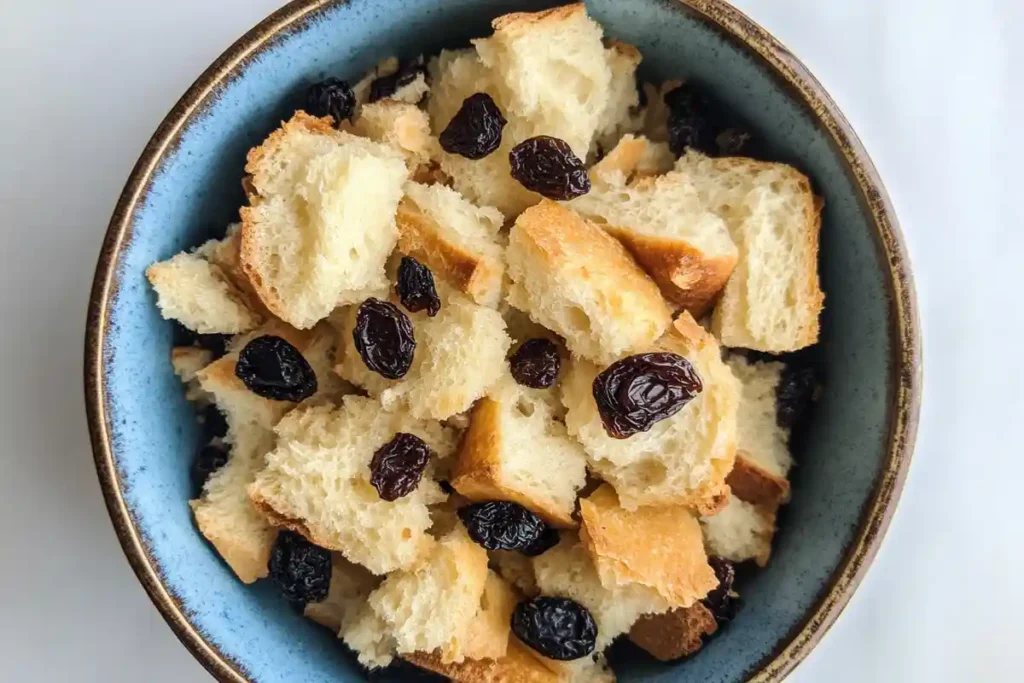
Cutting or Tearing the Bread into Cubes
Begin by cutting or tearing your sourdough bread into evenly sized cubes, about 1-inch pieces. The size matters because smaller pieces may turn mush, while larger pieces might not absorb enough custard.
For a rustic appearance, hand-tearing the bread works beautifully, and it adds a bit of charm to the presentation.
Drying the Bread for Better Texture
Day-old bread is ideal because it’s naturally drier and can soak up the custard without disintegrating. However, if you’re working with fresh bread, don’t fret. Simply spread the bread cubes on a baking sheet and toast them lightly in the oven at 300°F (150°C) for 10-15 minutes. This step ensures your bread has the perfect texture for the creamy custard mixture.
Tips for Evenly Sized Pieces
Uniformly sized bread pieces are essential for consistent baking. If some pieces are too large or too small, you might end up with unevenly cooked pudding—some parts could be dry while others turn overly soft. Taking some extra time here will pay off when you dig into that perfectly baked pudding.
Making the Custard Mixture
The custard is the heart of any bread pudding; getting it right is essential. Here’s how to whip up a rich, velvety custard that complements the tangy sourdough bread:
Mixing Eggs, Sugar, Milk, Cream, and Flavorings
- Whisk the eggs and sugar in a large mixing bowl until the mixture is smooth and slightly frothy. It ensures the sugar dissolves evenly, preventing gritty spots in your pudding.
- Gradually add the milk and cream while whisking continuously. The combination of milk and cream creates a luxurious texture, but feel free to adjust the ratio if you prefer a lighter custard.
- Stir in the vanilla extract, a pinch of cinnamon, and a dash of nutmeg. These warm spices add depth and an inviting aroma to the dessert. You can also customize the flavor profile with almond extract or a splash of rum for a boozy twist.
How to Achieve the Perfect Custard Consistency
For a silky-smooth custard, ensure all ingredients are well combined without lumps. If you’re adding ingredients like pumpkin puree or citrus zest, mix them thoroughly to ensure even distribution.
Pro tip: Strain the custard mixture through a fine-mesh sieve before pouring it over the bread. This removes any eggy bits and ensures a creamy consistency.
Combining Bread and Custard
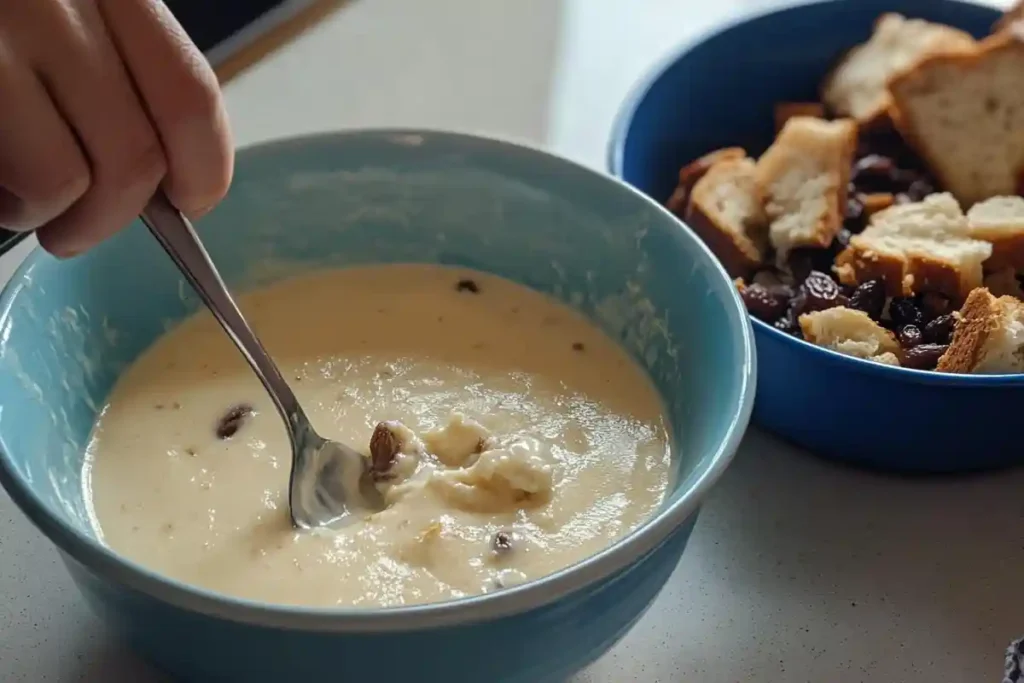
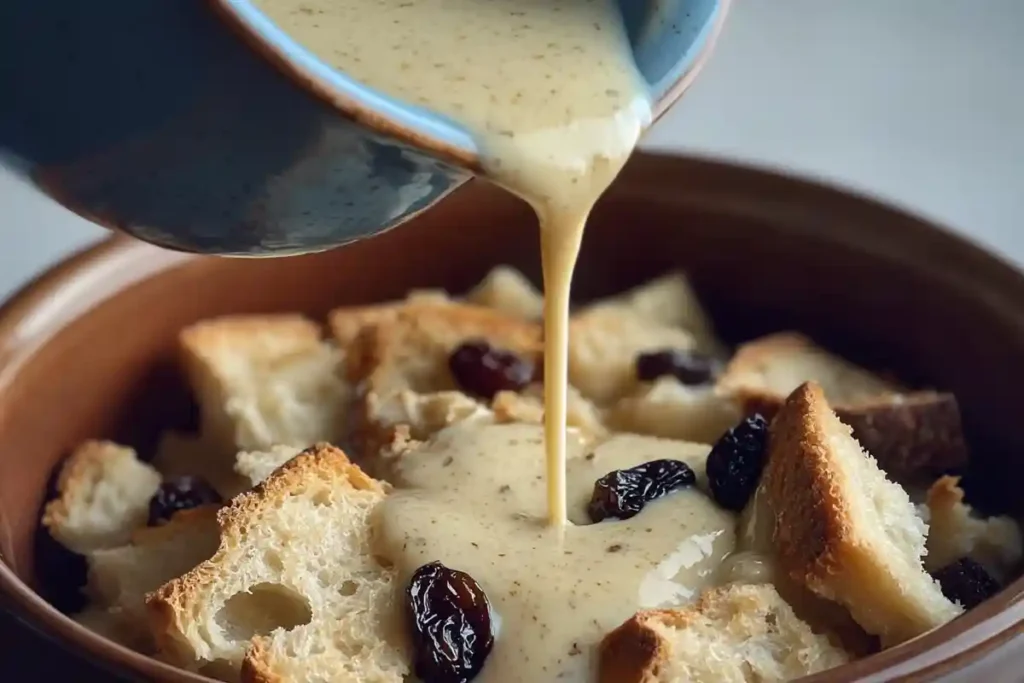
Now comes the fun part—assembling your sourdough bread pudding recipe. Follow these steps for the best results:
Layering the Bread in a Baking Dish
- Grease your baking dish with butter or a non-stick spray to prevent sticking.
- Arrange the bread cubes evenly in the dish, ensuring no large gaps. If you’re using add-ins like raisins, nuts, or chocolate chips, layer them in with the bread.
Ensuring Even Custard Absorption
Slowly pour the custard mixture over the bread cubes, making sure every piece is well-coated. Use a spatula or the back of a spoon to gently press the bread into the custard, helping it absorb the liquid. The goal is for the bread to soak up the custard evenly, but don’t overdo it—there should still be a bit of liquid visible to keep the pudding moist during baking.
Letting the Mixture Rest Before Baking
This step is often overlooked but incredibly important. Allow the bread and custard mixture to rest for at least 20-30 minutes before baking. This gives the bread enough time to fully absorb the custard, ensuring a creamy, cohesive texture in the finished dish.
Baking the Perfect Sourdough Bread Pudding
Once your bread and custard mixture is prepped and rested, it’s time to bake it to golden perfection. Here’s how to do it:
Recommended Oven Temperature and Timing
- Preheat your oven to 350°F (175°C).
- Cover the baking dish loosely with aluminum foil and bake for 25-30 minutes. It prevents the top from browning too quickly.
- After 30 minutes, remove the foil and continue baking for 15-20 minutes, or until the top is golden brown and slightly crisp.
Signs That Your Bread Pudding is Done
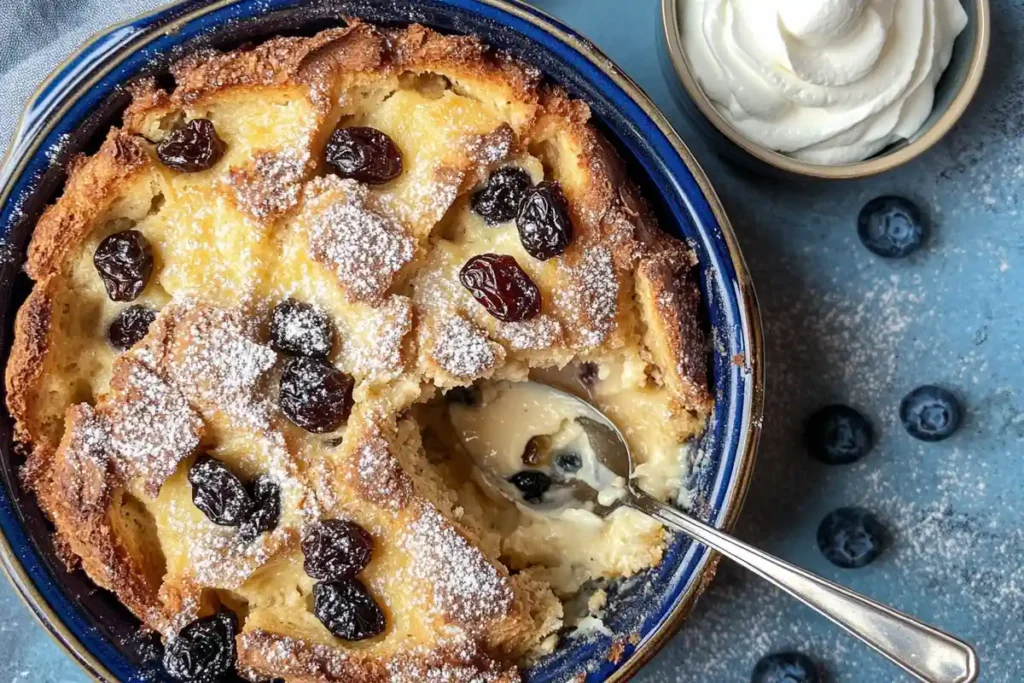
To check if your bread pudding is ready, insert a knife or toothpick into the center. If it comes out clean or with just a few moist crumbs, it’s done. The pudding should be set but still slightly jiggly in the middle—that’s how you know it’s wet without being undercooked.
How to Avoid Mushiness or Dryness
- Mushy pudding often results from using overly fresh bread or failing to dry it properly. Ensure your bread is slightly stale or toasted before assembling the dish.
- Dry pudding can occur if there’s not enough custard or overbaked. Keep an eye on the baking time and use a generous amount of custard to moisten the dessert.
Creative Ways to Serve Sourdough Bread Pudding
Congratulations! Your sourdough bread pudding recipe is perfectly baked and ready to be enjoyed. Now comes the fun part—serving it up with flair. This versatile dessert can be dressed or kept simple, depending on the occasion. Whether hosting a dinner party, celebrating a holiday, or indulging in a cozy night at home, these serving suggestions will make your bread pudding unforgettable.
Pairing with Sauces
Adding a decadent sauce is one of the easiest ways to elevate your sourdough bread pudding. A drizzle of sauce enhances the flavour and gives the dessert a professional, restaurant-quality finish.
- Vanilla Sauce: A classic choice that beautifully complements the tangy sourdough and warm spices. It’s creamy, sweet, and subtly fragrant.
- Caramel Sauce: This rich, buttery topping adds a luscious sweetness that pairs perfectly with the pudding’s slightly tangy notes.
- Bourbon Sauce: For an adult-friendly twist, try a bourbon-infused sauce. Its smoky, boozy flavor adds depth and sophistication to the dessert.
- Chocolate Ganache: A thick layer of chocolate ganache will delight chocolate lovers and turn your bread pudding into a truly indulgent treat.
Simply drizzle or pour the sauce over individual portions before serving. You can also offer multiple sauce options for your guests, adding a personalized touch.
Garnishing Ideas
Sometimes, the simplest garnishes can have the biggest impact. They enhance the presentation and add textural contrast and bursts of flavor. Here are some easy yet effective garnishing ideas:

- Fresh Fruit: Add a pop of color and freshness with sliced strawberries, raspberries, or blueberries. The tartness of the fruit pairs wonderfully with the richness of the pudding.
- Nuts: Sprinkle toasted pecans, walnuts, or almonds on top for a crunchy contrast to the soft, creamy texture of the pudding.
- Whipped Cream: A dollop of freshly whipped cream adds an airy lightness that balances the dessert’s richness.
- Powdered Sugar: Dusting the top with powdered sugar is a simple yet elegant way to finish the dish.
- Zest: A touch of citrus zest—like orange or lemon—can brighten the flavors and add a subtle aromatic note.
These garnishes can be mixed and matched to suit your preferences or to align with seasonal themes.
Storing and Reheating Sourdough Bread Pudding
If you have leftovers (though they might not last long!), proper storage and reheating techniques are key to maintaining the dish’s texture and flavor. Here’s how to keep your bread pudding tasting as good as the day it was made.
Best Practices for Refrigeration
- Allow the bread pudding to cool completely before refrigerating it. Placing it in the fridge while still warm can create condensation, leading to sogginess.
- Once cooled, cover the baking dish tightly with plastic wrap or transfer the pudding to an airtight container.
- Refrigerate for up to 3-4 days. After this point, the quality may decline, but the pudding will still be safe to eat.
Can You Freeze Sourdough Bread Pudding?
Yes, you can freeze bread pudding for longer storage! Here’s how:
- Portion the pudding into individual servings. This makes it easier to reheat only what you need.
- Wrap each portion tightly in plastic wrap, then place them in a freezer-safe bag or container.
- Freeze for up to 2 months.
When you’re ready to enjoy it, thaw the pudding in the fridge overnight before reheating.
Reheating Techniques for Maintaining Texture and Flavor
Reheating bread pudding can be tricky, as you want to warm it through without drying it out. Here are a few methods to ensure the perfect texture:
- Oven Method: Preheat your oven to 325°F (165°C). Cover the pudding with aluminum foil to prevent it from drying out, then heat for 15-20 minutes, or until warmed through. Remove the foil during the last few minutes of heating for a crispier top.
- Microwave Method: For a quick option, microwave individual portions on medium power for 1-2 minutes. Add a small milk or cream splash before microwaving to moisten the pudding.
- Stovetop Method: If reheating a single serving, use a skillet on low heat. Add a splash of milk or cream and stir gently until warmed through.
No matter the method, serving reheated bread pudding with fresh sauce or garnishes will revive its flavors and presentation. It’s just as delicious the next day!
FAQ’s About Sourdough Bread Pudding Recipe
Why is sourdough bread not fattening?
Sourdough bread is less fattening than other bread types due to its fermentation process, which lowers its glycemic index and helps you feel fuller with smaller portions.
Why is my bread pudding mushy?
Mushy pudding happens when the bread is too fresh or not dried properly before adding the custard. Use day-old sourdough or lightly toast fresh bread cubes to prevent sogginess.
What are the essential ingredients for bread pudding?
The basics include sourdough bread, milk or cream, eggs, sugar, vanilla, and spices. Optional add-ins include raisins, nuts, chocolate chips, and toppings like caramel sauce.
Is sourdough healthier than regular bread?
Yes! Sourdough is easier to digest, has a lower glycemic index, and contains probiotics, making it a healthier choice for bread pudding and beyond.

